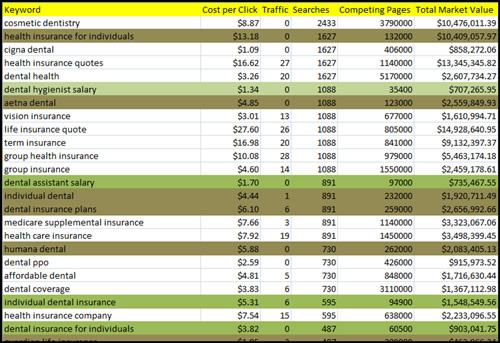Overcoming competitive markets is one of the most challenging facets of SEO. You are virtually in the trenches duking it out daily pitted against some of the most fierce competition imaginable. Make a mistake and someone takes your spot as you regroup for the next bout with the search engine as the referee.

SEO is Not about Excuses, Only Results!
The battle for market share constantly sways in the balance as enterprise level conglomerates house teams of SEO’s, marketing and brand managers with virtually limitless budgets at their disposal, silently fuel the various facets of PR, SEO and internet marketing.
The reason why a major player would seek to occupy a keyword monopoly on web estate spanning a virtual cornucopia of highly trafficked phrases is obvious, they understand the rewards that a top ranking for a competitive keyword can yield.
Add to the fact that your competition has more than likely got the jump on you months or years ago and has been raking in the dough for years in the search engine result pages and one thing is clear, you need an equalizer.
In the past, I have hinted in a previous post that every website has an SEO ceiling (a competitive threshold representing its most challenging keyword). Finding this competitive SEO threshold or determining how to leverage the natural optimization process as it unfolds however requires tactful execution and competitive market intelligence.
Under this premise, the notion is to create topical continuity (from theming and siloing your website) to provide dynamic ranking power for multiple keywords simultaneously. Yet, siloing is not always enough, you will need to sprinkle the finishing touches on those silos to get the money out of the vast array of themed content that was so meticulously segmented intentionally by using a technique (at the end of this post).
Theming and siloing promotes an astonishing array of ranking power which is primarily supported by its own internal link dynamo. Wikipedia uses this technique (the power of co-occurrence and internal linking) to rank for millions of keywords (we elaborate on this tactic in the following SEO video).
Essentially, each time you mention a specific keyword or semantic topic (such as market research, competitive intelligence, market analyst or competitive research) it is tallied as a vote in your factor for topical relevance. Eventually, if you cross the tipping point and gain authority, you can rank for all of the keywords over time.
Over time if a website had dozens of pages on each topic, you could ball roll them together to consolidate their collective ranking power. Search engines already do this when they parse the index using singular value decompression(SVD) like the card game concentration “and match queries and content” with the “it/not it” signature as a relevance stamp for query space.
If your website contains multiple hits at the page level and multiple hits at the global level, then your relevance score for the said keywords contained in the query create a phenomenon similar to a vacuum and ear mark those pages as a relevant hit.
Over time, the value of this relevance (through staying on topic) becomes immense as search engines start to associate your website as a hard coded reference to “more information on the topic” by default, and as a result, it becomes easier for you to rank for any keywords related to the topic.
This is the value of being a specialist (siloing and using proper naming conventions); search engines reward bodies of knowledge or useful information (it makes them look good to end users for having such great taste). So, the unspoken rule is to implement a diverse array of topical information about a subject to exhibit and hence gain more authority on that topic. Authority means ranking power, which is the entire purpose of SEO.
Once you cross the tipping point / threshold for multiple page level queries (closer akin to exact match queries), your website becomes more reputable and the process of keyword stemming occurs and you virtually start ranking for more nebulous or broad match variants of multiple (unintentional keywords).
Unintentional keywords (under this premise) suggest that your website appears for more long-tail keywords (long-tail implying a longer queries such as 4-7 words vs. a two word search).
What you may notice in the beginning is that keywords with singular and plural variations are essentially interchangeable and act like the buddy system to pull additional keywords into the spotlight.
As this process evolves, more competitive keywords appear on the horizon and your website can virtually devour a niche if managed properly with proper content, internal links and accommodating site architecture.
Say for example, you have a page that ranks in the top 10 for one modifier and “consulting” and you have another page that ranks in the top 10 for another modifier and the word “rates”. If you have enough information about a 2-3 word query (such as “consulting rates”) which contains the two overlapping keywords for both on a random page, it could become a mid-tail keyword candidate to bridge the gap of relevance between the two.
In order to maximize this phenomenon you need to pay close attention to keywords that occur further down the funnel. In analytics, the deeper you go, the more information you can extract about how your website is potentially encroaching on a broader array of keywords.
For example, to find new keyword niches, you should look at the bottom of the funnel or at keywords that only have a few hits on your most popular pages. From there, you can extract which stemmed variations are getting through and then consider making new pages to capture them with a preferred landing page. Server logs are also a great way to find hidden keyword gems.
The less competitive the keyword, the less content you need to cross the tipping point. Eventually what is considered competitive will become relative as a website gains more authority and topical relevance. Our website for example, can devour keywords up to 4 million competing pages due to the reputable array of content, trust and rapport it has established from touching on so many topics.
What I am suggesting is that you can accomplish the same around a very specific array of keywords grouped in clusters, which in turn produce multiple first page rankings (due to the competitive thresholds being overcome through topical relevance).
Eventually the site begins to scale the ladder and is capable of acquiring more competitive keywords over time (and pulling up other related pages, etc.).
Mind you that this process usually happens for content-rich sites that are employing vast silos (siloing implies employing a themed site architecture where the theme is the topic/subfolder and the silos are additional pages on the subject) quite naturally.
The Final Technique:
Over time, you need to get the investment out of the well and funnel that vital link flow back to a more ample page for conversion. One way to harness your silos (keyword-rich content segments) is to incorporate a beacon / landing page in the root folder (using a play from the flat site architecture SEO 101 technique).
Sounds simple enough, for those who swear by flat site architecture, I concur, it really works. However, by coupling the two (using silos to feed root level exact match url, H1 and internal link preferred landing pages) its a whole new world of SEO.
Pages in the root folder are fed by continuity from the homepage and the fact that PageRank flows upward (and spills over from page to page) depending on the degree of the internal link graph a website uses.
To expedite the process consolidate your links. For example if you have 45 pages about “Topic A” then create a “Topic A” landing page to use as a target for all of that buoyant page rank and then build links from the silos to those root level preferred landing pages.
Consider this payment in full for your hard earned SEO work invested into theming and siloing. Get it right and your entire notion of “competitive keywords” will go right out the window along with the competitors you previously thought of as untouchable as you replace them in the SERPs (search engine results page) with ease.










Great post Jeffrey. You guys are really giving out loads of gems of advice on your site and I find myself being hooked to your website. Thanks.
Thanks Mauco:
You have to figure two things (1) if we didn’t someone else would and (2) many of the techniques will be zeroed out in the future anyway, due to abuse or algorithm changes, so, since SEO is always in flux, it doesn’t hurt to share a few gems.
Naturally we keep the good stuff “close to the chest”…
The concept you propose really is like creating a number of topical mini-sites within the website, all interconnected. This is not only good for the search engines, but also for people trying to navigate the information. If someone is looking for information on beam bending, he does not need to search amongst pages about tube bending, since all the beam-bending pages would interlink.
@David:
To add to that point, each variable with a few pages on a topic can also be utilized to elect a preferred landing page.
So, if they are using mid to long tail phrases, the exact match pages with the highest degree of relevance would appear in a double ranking since keywords overlap in silo’s like a common thread.
Nothing like a 200% increase in serp positioning from bumping someone else off the page as well as a relevant hit to increase conversion.